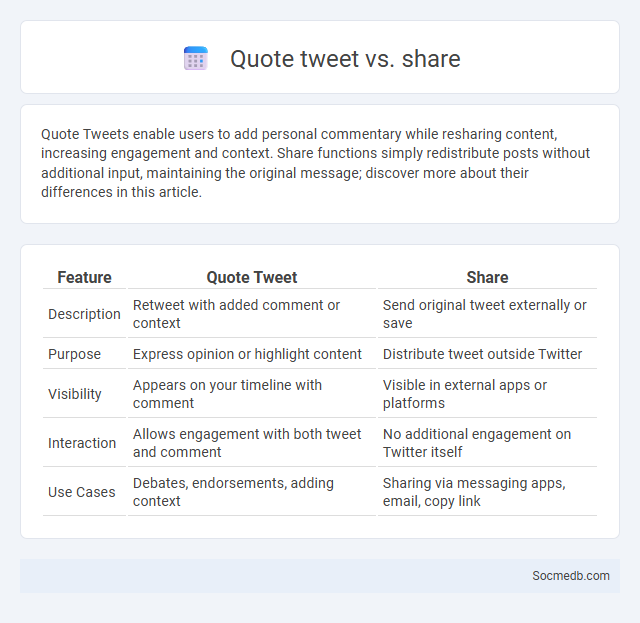
Photo illustration: Quote Tweet vs Share
Quote Tweets enable users to add personal commentary while resharing content, increasing engagement and context. Share functions simply redistribute posts without additional input, maintaining the original message; discover more about their differences in this article.
Table of Comparison
| Feature | Quote Tweet | Share |
|---|---|---|
| Description | Retweet with added comment or context | Send original tweet externally or save |
| Purpose | Express opinion or highlight content | Distribute tweet outside Twitter |
| Visibility | Appears on your timeline with comment | Visible in external apps or platforms |
| Interaction | Allows engagement with both tweet and comment | No additional engagement on Twitter itself |
| Use Cases | Debates, endorsements, adding context | Sharing via messaging apps, email, copy link |
Understanding Quote Tweet: Definition and Purpose
Understanding quote tweets enhances your social media engagement by allowing you to share another user's tweet while adding your own commentary, providing context or opinion. This feature boosts interaction by encouraging deeper conversations and increasing the visibility of original content through personalized amplification. Utilizing quote tweets effectively can expand your reach and foster community interaction on platforms like Twitter.
What Does Share Mean on Social Media Platforms?
On social media platforms, "share" refers to the action of redistributing content such as posts, images, videos, or links to a user's own network or timeline, amplifying the original message's reach. Sharing enables users to engage with content by endorsing, spreading, or commenting, thereby increasing visibility and fostering community interaction. This feature plays a pivotal role in viral marketing, brand awareness, and information dissemination across platforms like Facebook, Twitter, Instagram, and LinkedIn.
Quote Tweet vs Retweet: Key Differences
Quote Tweets add your personal comment above the original tweet, increasing engagement by combining your voice with the shared content, while Retweets simply share the original post as is, amplifying its reach without added commentary. Your choice between a Quote Tweet and a Retweet affects how your followers perceive and interact with the content, influencing visibility and conversation dynamics. Understanding these key differences helps optimize your social media strategy for maximum impact.
Quote Tweet vs Share: Which One to Use?
Quote Tweet allows users to add personal commentary while sharing the original tweet, increasing engagement and providing context. Share simply distributes content without added input, ideal for quick dissemination and broader reach. Choose Quote Tweet to spark conversations and Share for rapid, widespread content exposure on social media platforms.
Impact on Engagement: Quote Tweet vs Share
Quote Tweets often generate higher engagement by allowing you to add personal commentary, sparking conversations and attracting attention to your content. Shares, while expanding reach by distributing content to a broader audience, typically result in less direct interaction since they lack additional user input. Choosing Quote Tweets helps deepen audience connection and increases interactive responses compared to standard Shares.
Visibility and Reach: Comparing Quote Tweet and Share
Quote Tweets amplify content visibility by allowing users to add commentary, which encourages engagement and attracts diverse audiences beyond the original followers. Shares (or retweets without comment) primarily extend reach by broadcasting the content to a user's network without alterations, preserving the original message's intent. Studies show Quote Tweets generate higher interaction rates, while Shares offer broader, quicker dissemination across social media platforms like Twitter and Facebook.
Content Control: Benefits of Using Quote Tweet
Quote Tweet enhances your ability to control content by allowing you to add personalized commentary while sharing original tweets, ensuring your message stays clear and aligned with your brand. This feature enables you to contextualize information, add insights, and guide audience perception without altering the original content. Using Quote Tweet effectively increases engagement and maintains the integrity of shared information across social media platforms.
User Intent: When to Quote Tweet vs When to Share
Quote tweeting is effective for adding personal commentary or context to an original post, enhancing engagement and driving conversations. Sharing, on the other hand, is best for straightforward amplification of content without altering the original message, ideal for spreading information quickly. Understanding user intent helps optimize social media strategy by tailoring interactions to either provoke thought or maximize reach.
Best Practices for Quote Tweeting and Sharing
Quote tweeting enhances engagement by adding meaningful commentary or context to the original post, which encourages thoughtful discussions and more retweets. Sharing content with relevant hashtags and tagging original creators increases visibility and acknowledges sources, fostering community trust. Using concise, clear language and aligning quotes with your brand voice ensures your posts resonate and maintain authenticity across platforms.
Choosing the Right Feature: Quote Tweet or Share?
Choosing the right feature between Quote Tweet and Share depends on your social media strategy and the context of your content. A Quote Tweet allows you to add your perspective or commentary directly to the original tweet, enhancing engagement by providing additional value or insight for your followers. Sharing, on the other hand, simply amplifies the original content without modification, making it the ideal choice when you want to promote or endorse a message quickly and clearly to your audience.
 socmedb.com
socmedb.com